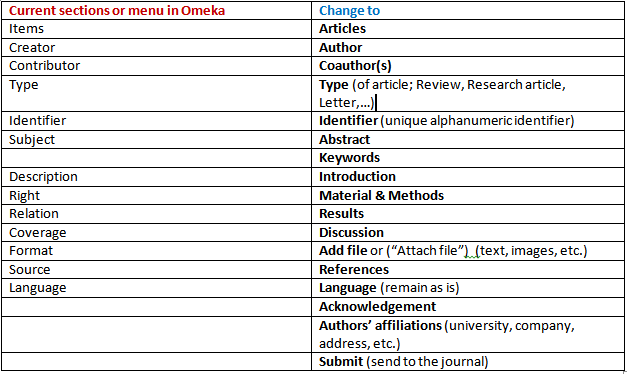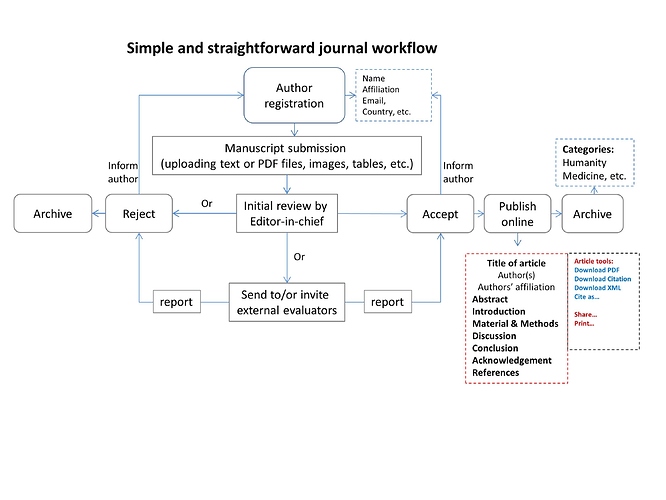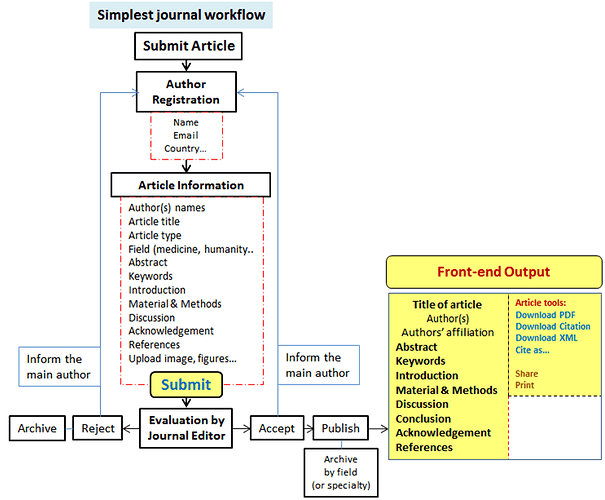Thank you for your answer.
The “Pressforward” WordPress plugin does not fully answer scholarly publishing requirements.
Acutally, Omeka can do it much better than WordPress provided some minor changes and tweaks where not so much would be needed to make Omeka as a powerful journal manager. See the attached screenshot and table below for the potential/required changes to make.
The workflow is relatively simple (see attached picture):
With simple changes in the current Omeka (see the table below), the job would be done smoothly:

The table shows that;
“Items” in the current version of Omeka should be changed into “Articles”
“Collections” into “Categories” (where authors can select the specialty of their articles from a dropdown menu such as “humanities, history, medicine, psychology, philosophy, chemistry, biology, etc.)
“Item type” into “Article type” where the authors can select the type of their articles (Review, Research Paper, Essay, Opinion, Letter to the Editor, Case study, etc.)
“Add Item” into “Add Article” (and “Add Collection” into “Add Category”).
“Creator” into “Author”
“Contributors” into “Co-author(s)” and (Add contributor to “Add coauthor”)
“Identifier” remains as is; the editor in chief can assign to the article a DOI (Digital Object Identifier) or any other unique identifier customizable by the user (such as serial or sequential alphanumerical symbols created by the system in a sequential way or a combination of the date and journal name, etc.)
“Type” remains as is where the submitter can select the type of his submission from a dropdown list (“Review, Research paper, Opinion, Letter to the editor”, etc.)
“Subject” into “Abstract” where the author can write her his or her Abstract (or copy/paste it from a text file).
“Description” into “Introduction” (where the author can write down or copy/paste his or her introduction from a third text file (Word document, etc.)
“Right” into “Materials & Methods, where the author (submitter) describe his or her method
“Relation” into “Results” where the authors can add or copy/paste the results s/he obtained.
“Discussion”: where the authors write discussion of the obtained results or observations (or copy/paste it from their text file)
“Conclusion”: the authors can write a conclusion (or copy/paste it from their text file)
“Attach files”: here, the author can attach a Text or PDF File containing all the information above in one text or PDF file.
“Acknowledgement”: here, the author can write any statement (funding notice, conflict of interest, thanks, etc.).
“References”: the author can provide the list of references they cited in their article (the source).
After providing the information above, the authors can send them to the journal by clicking on a “Submit” button to send the article information and files to the journal.
The journal manager or Editor in Chief will then be notified to assess the received articles where s/he can decide to publish it without changes or Invite other Peers or Reviewers to evaluate it after which he can decide to publish it or reject it depending on the recommendations received from evaluators or to ask authors to make changes required by the reviewers before publishing.
The editor in chief or journal manager can publish accepted article by clicking on a “Publish” button that should Preview the article before the formal publication on the site.
After publication, some article tools should be added or available for the reader, for example
Download PDF file (the reader can download a copy of the paper as a PDF file)
Download XML file (for indexing database
Download citation (for bibliography manager in Zotero, Endnote, Bibtex, etc).
Print…
Share…
That’s it!
Unfortunately, I am not developer to make such changes but I think it would be relatively simple and straightforward for savvy and skilled developers, particularly Omeka developers because they know Omeka better than anyone else! !


